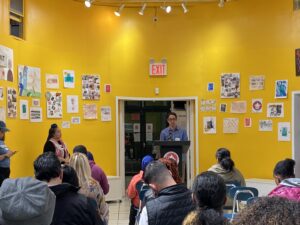Community policing is a term that is used a lot in discussion of police department reform and accountability measures. I don’t just mean that it is common amongst activists and civil rights leaders, but within police departments themselves. The term community policing has appeared in mission statements of police departments across the country and around the world for decades and has continued to become increasingly common in recent years. But, for a concept that has floated around in the criminal legal reform ether for so long, the term is surprisingly ambiguous. Eighty-one percent of the U.S. population is under the jurisdiction of an enforcement agency that has adopted community policing practices, yet what this means in practice varies widely.
There isn’t common agreement on why community policing hasn’t taken hold in the philosophies and structures of police departments nationwide. However, based on a review of literature on community policing practices and current implementation methodologies, three major barriers stand in the way of nationwide institutionalization of community policing. These are: a lack of consistent political will, standardization, and evaluation measures. First, a lack of consistent political will makes it difficult to implement practices with the intent of fundamentally shifting the structure and philosophies of police organizations. Second, community policing policy lacks standardization, which leads to police departments implementing policies that vary in substance and may not resemble community policing models. This in itself exacerbates the impact of a third barrier, which is a lack of consistent and effective means of evaluating community policing practices. In this first article in the series, I’ll explore what community policing is and the various attempts to implement it, focusing on New York City.
What is community policing anyway?
Before I get into the weeds, we should talk about what community policing is so we’re all on the same page. The idea of community policing, originating in the early 1970s, was a product of changing beliefs about the role of police–from reactionary bodies to proactive problem solvers. The concept pushed back against 40 years of expansion and organization of police departments into uniform, centralized institutions and was seen as a remedy to rapidly deteriorating community relations. Despite being around for 50 years, there is no gold standard definition of community policing. According to Community Oriented Policing Services (COPS), the Department of Justice (DOJ) office responsible for advancing nationwide community policing practices, it is meant to typically consist of three components: problem solving, community partnership, and organizational transformation.
Problem solving, in this context referred to as problem oriented policing, is an approach to identifying and solving systemic issues in a community by tackling underlying issues in the community that are causing crime. This strategy, to prevent individual crimes from happening in the first place, is in direct contrast to decades of traditional police practices, which are organized around reacting to individual crimes during and after they occur. In community policing models, problem solving is meant to be a collaborative partnership between communities and law enforcement.
The term community is broadly defined, which poses a challenge when it comes to consistent implementation, but can include community member groups, non-profits, or service providers among others. The purpose of community partnerships is not only to make police more effective problem solvers by leaning on the community’s knowledge of their partners, but also to create positive relationships between police and the communities they serve.
Finally, organizational transformation is needed to implement the first two components of the community policing model. Transformation consists of police departments re-envisioning their physical command structure to allow for decentralized decision making. Decentralization gives frontline officers autonomy in their actions and allows for changes to the department to create philosophical shifts that are in alignment with community policing practices like personnel practices, management policies, and information technology systems.
In practice, these components and the extent to which they are utilized look different from department to department. One example of a program that incorporates all of the components of community policing is the Resident Officer Program of Elgin (ROPE) in Elgin, Illinois. The Elgin Police department transformed its force to designate specific officers to live in neighborhoods designated as “distressed” with the capacity to interact with community members, problem solve, and act independently.
Political Will or Lack Thereof
Political will to implement community policing practices has historically varied. As the idea was first emerging, it received attention at the federal level through The President’s Commission on Law Enforcement and Administration of 1967. However, community policing didn’t gain much traction throughout the 1970s and early 1980s. The practice was perceived by police departments as “soft” and more appropriate for social service providers than for police, which were meant to be “crime fighters.” However, in New York City, various successful pilot programs emerged such as the 1984 Community Patrol Officer Program which took place in 75 precincts by 1988. The program consisted of special units within precincts made up of community patrol officers. These officers were responsible for a particular geographic beat and were meant to act as planners, problem solvers, community organizers, and information exchange links. This program was characterized in evaluations as, “A reasonably successful effort to move the New York City Police Department in a desirable direction.” It had many of the characteristics of what a community policing program was meant to be.
However in the 1990s, the strategy of the NYPD shifted in response to high levels of crime. This could be seen in the approaches taken in the mid 90s by New York City Mayor Rudy Guliani. When elected, Mayor Guliani and Police Commissioner William Bratton popularized the broken windows philosophy, which posited that minor instances of social and physical disorder – hence “broken windows” – create a culture of lawlessness and encourage more crime. In practice, this strategy involved aggressively making arrests for low level offenses, particularly in communities of color. Although it was a shift toward the problem oriented policing practices utilized by community policing models because it moved away from reactive enforcement toward crime prevention, the practice was a fundamentally different philosophy from community policing. Both strategies focused on police being actively involved in communities, but broken windows focused on policing communities in an enforcement capacity while community policing focused on officers interacting in a non-law enforcement capacity. Community policing also places emphasis on cultivating community partnerships and positive community relationships which broken windows did not. Ultimately, the broken windows strategy received vast criticism for deteriorating community relationships through practices that were unsupported by evidence. Broken windows policing in New York, which became a building block for police departments across the country, demonstrated how elements of community policing were being utilized by departments but the concept itself was not being implemented as intended on a wide scale.
Despite the popularity within police departments of broken windows strategies, the implementation of community policing models gradually increased in the late 1990s and early 2000s. The practice gained a lot of momentum in the 2010s and was a large piece of President Obama’s Task Force on 21st Century Policing in 2015. National focus was reflected at the local level in places like New York where Mayor De Blasio made community policing a part of his NYPD Plan of Action led by then again Police Commissioner William Bratton, the same man responsible for broken windows under the Guliani administration.
This program was very much structured in the same vein as CPOP in the 1980s. Its intention was to change organizational structure by creating neighborhood policing units within precincts. Officers dedicated to specific geographic areas were tasked with facilitating problem solving and engaging in community partnerships. By 2018, the initiative was in every precinct in New York City. The RAND Corporation, an independent research organization, was contracted to evaluate the extent to which the program affected crime and community trust, however that study has yet to be publicly released due to continued delays. In a preliminary citywide survey administered by the RAND Corporation in 2021, a majority of people citywide agreed that police address neighborhood problems, don’t allow racial bias to affect their actions, and make their neighborhoods a better place; however public responses were far less favorable when broken down by neighborhoods with high and low levels of violent crime. The program also struggled to significantly improve community relations especially as tensions increased in the wake of high profile police murders like that of George Flloyd. While it is difficult to say based on the information that is available, it’s possible the program was effective but just not big enough. The neighborhood policing departments were individual units within a much larger system, in fact the largest system in the country. It is difficult for a program to have a meaningful impact both on the community it serves and on creating organizational change when it is relatively small in size compared to the NYPD at large. Criminal legal reform advocates have criticized the program for this reason and characterized it as more of a public relations strategy than a means to radically restructure the NYPD.
The Adams Administration has called for a return to broken windows style policing of low level offenses and the reinstatement of Anti-Crime teams, units that had been disbanded due to civil rights abuses, under a new name: Neighborhood Safety Teams. According to the NYPD, the purpose of these teams is to promote crime reduction, precision policing, and community engagement in areas with high levels of crime. Just like with broken windows policing, Mayor Adam’s new approaches share community policing’s commitment to proactive policing and problem solving versus reactive policing, but that’s where the similarities end. The specific purpose of the program is to combat gun violence. While combating gun violence is important, it’s not the only problem that communities with high levels of crime experience and the specific focus does not leave much room for community input in problem solving efforts. Moreover, the program has been criticized for a lack of community engagement, a major tenet of community policing.
The administration’s move away from community policing practices again represents how shifting political will affects the capacity for instituting meaningful change in departments over time. It represents a multi decade pattern that has stifled community policing from being as common in practice as it is in rhetoric. But political will isn’t the only thing preventing wide scale implementation of community policing practices. In the next piece in the series, I’ll discuss why even when political will is present, it’s been so difficult to incorporate community policing into our police departments. Click the link below for part two of this series.
Part Two: What Stands in the Way of Community Policing?
[author] [author_image timthumb=’on’]https://www.publicworkspartners.com/wp-content/uploads/2022/02/NoahBrook-2022.jpg[/author_image] [author_info]Noah is a first-year graduate student at NYU Wagner where he is specializing in policy analysis. He previously worked as a court advocate at CASES, one of the largest providers for alternatives-to-incarceration in New York City. During his undergraduate years, Noah gained direct service experience in various sectors of the criminal legal system. Upon earning his master’s degree, Noah hopes to pursue a career at the intersection of research and advocacy to promote a compassionate criminal legal system shaped by evidence-based practices and lived experiences.[/author_info] [/author]





 Public Works Partners is a WBE/DBE-certified urban planning and consulting firm. Our expertise lies in creating innovative, equitable, and sustainable solutions to complex problems.
Public Works Partners is a WBE/DBE-certified urban planning and consulting firm. Our expertise lies in creating innovative, equitable, and sustainable solutions to complex problems.